Opinion & Analysis
Are Cobra’s F7 Junior One-Length Irons Good for Youth Golf?
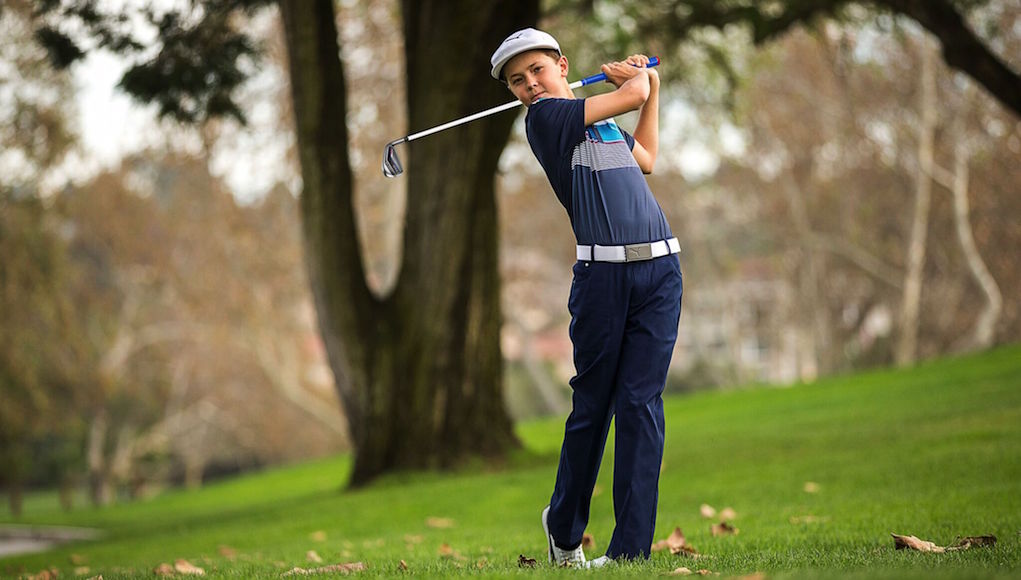
Golf equipment companies that make clubs for junior golfers are in a difficult position. They need to look out for their business by turning profits, developing brand loyalty and ultimately making their customers happy. But these equipment companies also need to look out for the future of the sport, and get clubs in the hands of junior golfers that will properly develop their golf games.
As such, I want to have a conversation about Cobra’s new Junior F7 One irons, which are single-length golf clubs made for juniors aged 13-15 years old, and the possible consequences (negative or positive) of putting these clubs in their hands.
First, I’d like to commend Cobra on making a set of irons that may make the game easier for more junior golfers, and for being bold in its chase to simplify the game. The single-length iron sets were developed by Tom Olsavsky, the Vice President of R&D for Cobra, after thorough testing, study and input from Mike Schy, a proponent of The Golfing Machine theories and Bryson DeChambeau’s longtime swing coach. Although the single-length system is not widely accepted — not yet, at least — the concept of single-length irons is such that a golfer doesn’t need to change his/her swing between irons because they’re all the same length, weight and have the same lie angle. To make the golf ball go different distances, single-length irons clubs use different lofts and head designs. That certainly can simply things.
Junior golf equipment has come a long way from the days of simply cutting down adult sets, or using your father’s hand-me-downs. There are now many different options for golfers of different sizes and strengths, and that’s a wonderful thing. Also, Cobra gave these particular irons serious engineering attention and similar technologies as the adult, one-length sets.
Like the adult versions, the F7 Junior One irons have TechFlo — a technology designed to help the longer irons fly higher and farther — and they also have PwrShell faces, which means they are thinner and more forgiving across the face. The grooves are milled and designed to produce the proper spin for each individual iron. The clubs come stock with Lamkin EPDM REL-Red, White and Blue grips and graphite Fujikura Fuel Junior shafts (36.25 inches in length), and they come in a five-piece set (5-7-9-PW-SW) that sells for $449 available now at retail and online.
I question the effectiveness of buying a single-length club for a junior golfer who’s 13-15 years old — a fairly wide range of physical characteristics there — without getting fit, but that’s another argument for a different day. My particular worry is for junior golfers who plan to take the game seriously, and have hopes of competing in high school and attaining a college scholarship. Along with the benefits, there could be longterm drawbacks of using single-length irons at a young age.
As a former NCAA Division I golfer who used progressive, or “normal” length irons his entire career, I had a mostly positive experience with the single-length irons — for which I was fully fitted — during my experiment for a GolfWRX review. I’ve since switched back to a normal-length set of irons because of the limitations I felt with trajectory and distance control; the more time went on, the more I felt long irons went too low and short irons went too high. My shotmaking was also suffering around the greens.
For me, using single-length irons was an experiment that I underwent by choice, and switching back to “normal” irons was natural because my swing and mentality had developed using progressive-length irons. My fear for junior golfers ages 13-15 who are given a set of single-length clubs is that their swings would be ingrained under the single-length concept… a concept that isn’t necessarily for everyone. Junior golfers in the developing stage of their bodies and swings are impressionable, and switching back from the single-length set into normal length irons later in life could prove difficult. Also, their shotmaking could be sacrificed in the short- and long-run.
I spoke to top-100 fitter Scott Felix of Felix Clubworks, and Ryan Johnson, the 2015 Michigan Amatuer champion and a fitter at Carl’s Golfland, for their expert opinions on the topic. Felix said while the single-length system could be beneficial using the relatively shorter 5 iron in terms of contacting the center of the face more consistently — but not in creating more speed — the longer wedges may take away from touch and feel around the greens. He said while he wouldn’t necessarily recommend single-length irons to a junior golfer, he would evaluate their performance with the clubs and help the junior get what they play the best. Johnson added that the single-length system may be easier since it’s only one swing in theory, but that the system might work best for a one-plane type swing (which The Golfing Machine calls a “zero shift”) and for junior golfers who understand and embrace the concept. As an accomplished player himself, Johnson once tried the one-length system and found difficulty with the short irons and wedges because they flew too high and to the left, and said “I couldn’t even think about hitting a bunker shot with them.”
“I wouldn’t tell a junior golfer or a parent not to (buy a single-length set),” Johnson said. “I’d just give them a rundown of the concept and what it entails.”
Olsavsky, on the other hand, doesn’t see a downside to the single-length system. “If a kid can hit a 7-iron, [he or she] can hit every club in the bag,” he says, and that one-length irons will ultimately put less stress on the mind and body throughout a junior’s life if they stick to one-length irons. He described a short game test that Cobra performed on one-length wedges vs. normal-length wedges, where a group of 2-12 handicappers hit 20- and 30-yard shots, as well as a chip shot and a flop shot. The results of the test showed that shots hit with single-length wedges finished closer to the hole and were more preferred in three of the four locations.
Regardless of performance, however, junior golfers are influenced heavily by what they see on TV or what their friends are doing.
“Since working with Bryson DeChambeau to help bring this concept to life in two adult sets of irons earlier this year, we have had requests from retailers and consumers to offer a set of one-length irons for junior golfers,” Olsavsky said in a press release.
So let’s say a junior’s favorite golfer is Bryson DeChambeau and they see him using single-length irons. Obviously, they ask their parents to buy them a set of single-length irons because it’s “cool.”
Parents should proceed with caution here. If a child wants to compete at a high level, it’s a bigger decision than simply saying, “Oh, this is what the kid says he wants so I’m going to buy it for him.” Let’s remember, DeChambeau himself grew up using a conventional length set of irons and later switched.
That’s not to say single-length is the wrong decision, either. Some kids will absolutely thrive under a single-length system, and in turn have confidence they wouldn’t have otherwise. The game may be simplified and come easier for the junior golfer because of it, and make golf fun.
For others, their development may be stunted. That’s why seeking professional guidance in this circumstance is so crucial.

Cobra has this to say about the performance aspects of the clubs.
“We tested these irons among a wide range of skill levels ranging in age from 13-15 and we found that universally they delivered more consistency and better performance for these younger golfers,” Olavsky said in a press release.
Personally, I don’t doubt that to be the case. In a vacuum, the irons surely perform really well (it’s more of the long-term effects that have me nervous).
Let me make this clear: I’m not bashing Cobra for providing single-length irons as an OPTION for the youth, I’m simply warning parents and junior golfers that the decision to buy these clubs is an important one. It will have lasting effects, whether positive or negative. Before buying a set of single-length irons for a junior golfer, please have this conversation with them under the supervision of a professional fitter or teaching professional.
We don’t want to rob golf of the next Justin Thomas just because he/she idolizes Bryson DeChambeau, or vice versa.
- LIKE36
- LEGIT4
- WOW1
- LOL4
- IDHT4
- FLOP3
- OB5
- SHANK40
19th Hole
Vincenzi: The 8 best prop bets for the 2024 Masters
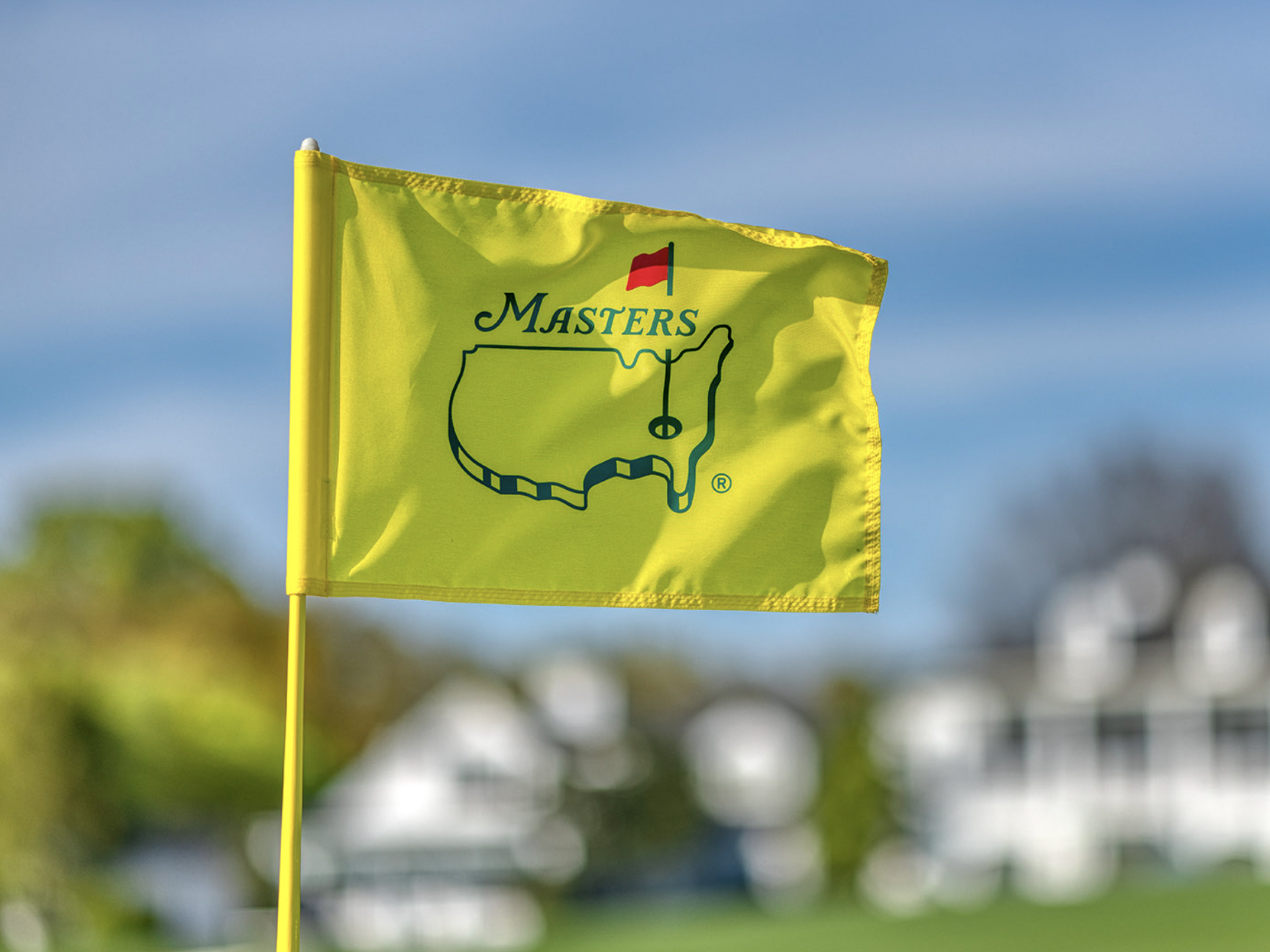
We’ve finally reached The Masters and excitement is at an all-time high. The world of golf has been fractured for the better part of two years, but for a week at Augusta National, all of the outside noise will disappear. All of the best players in the world will be together seeking to make history.
In addition to betting on The Masters champion. This is one of the few weeks of the year where there are so many more markets to explore, with value to be had in plenty of different categories.
Throughout this article, I’ll discuss all of my favorite props and players for the 2024 Masters.
Placement Bets:
Tony Finau Top 5 +750 (DraftKings):
I badly wanted to include Tony Finau in my outright betting selections, but I simply ran out of room on my card. Additionally, it’s slightly difficult to see him hitting the putts necessary to win the Masters on back nine on Sunday. However, I do strongly believe he will play great golf this week at Augusta National.
In his past 24 rounds, Finau ranks 4th in Strokes Gained: Approach is always amongst the best drivers of the golf ball in the game. Back in 2019, Finau had a great chance to win The Masters. I expect him to be hanging around over the weekend once again in 2024.
Gary Woodland Top 20 +550 (DraftKings), Gary Woodland to make the cut -110 (DraftKings):
Last season, Gary Woodland had his best ever finish at The Masters in his eleven tries. The 39-year-old finished T14 and played incredibly steady across all four rounds.
In Woodland’s most recent start at the Texas Children’s Houston Open, he struck the ball incredibly well. He led the field in Strokes Gained: Approach (+8.8) and Strokes Gained: Ball Striking (+10.0).
Gary has been working with Butch Harmon and absolutely flushing the ball both in tournaments and during practice.
Woodland appears to be healthy once again and in a great place physically and mentally. If he can build off his impressive performance at Augusta last year, he can place inside the top ten in 2024.
Additionally, the make the cut number on Woodland seems generous considering the number of players who miss the cut will be relatively small this week. Woodland is striking it well enough to make the cut even if he’s hindered by a balky putter once again.
Thorbjorn Olesen Top 20 +400 (FanDuel):
The Thunder Bear, Thorbjorn Olesen, made his Masters debut in 2013 and finished an incredibly impressive T6 for the week. In the two additional starts he’s made at Augusta National since then, the Dane has continued to be incredibly solid, finishing T44 and T21.
This week, Olesen heads into the week playing some good golf. He gained 3.8 strokes on approach and 5.52 strokes around the green at last week’s Valero Texas Open on his way to a strong T14 finish. Back in January, he won the Ras Al Khaimah Championship on the DP World Tour.
Olesen has the skill set to be successful at Augusta and seems primed for a good performance this week.
Top Nationalities:
Sergio Garcia Top Spanish Player +280 (DraftKings):
I believe Sergio Garcia can get into contention this week with the way he’s striking the ball in addition to his good vibes with a refurbished version of the Scotty Cameron that he used at the 1999 PGA Championship at Medinah.
I am slightly concerned about the emotional letdown he may face after losing in a playoff at LIV Miami, but I believe a veteran and former Masters champion should be able to regroup and focus on an event far more meaningful.
This is essentially a tournament head-to-head with Jon Rahm at +280. While Rahm deserves to be respected this week, the history of the lack of success of defending champions at The Masters is difficult to ignore.
Joaquin Niemann Top South American Player -230 (FanDuel):
While I hate paying this much juice, I don’t see a world in which Joaquin Niemann isn’t the top South American this week at The Masters. Joaco comes in playing better golf than anyone in the world not named Scottie Scheffler and has a serious chance to win the green jacket.
He only needs to beat two players: Emiliano Grillo and Camilo Villegas.
Tournament Head-to-Heads:
Justin Thomas -110 over Collin Morikawa
JT isn’t having his best season but is playing a lot better than he is getting credit for at the moment. In the past three months, there are only six players on the PGA Tour who have averaged 1.7 Strokes Gained: Tee to Green or better. Justin Thomas (+1.7) is one of the six and is currently tied with Rory McIlroy (+1.7).
Morikawa, on the other hand, has been extremely poor with his irons, which is incredibly uncharacteristic for him. I can’t help but feel like something is completely off with the two-time major champion.
Tony Finau -110 over Wyndham Clark
I explained in the placement section why I’m so high on Tony Finau this week. With how well he’s striking the ball, it seems as if his floor is extremely high. I’m not sure if he can make the putts to win a green jacket but I believe he will be in the mix similarly to 2019 when Tiger Woods emerged from a crowded pack of contenders.
Clark is a debutant, and while some debutants have had success at The Masters, it certainly poses a challenge. I also don’t believe Augusta National suits Clark as well as some of the other major championship venues.
- LIKE9
- LEGIT5
- WOW3
- LOL0
- IDHT0
- FLOP0
- OB0
- SHANK2
19th Hole
Vincenzi’s 2024 Masters betting preview: Niemann to play star role at Augusta National
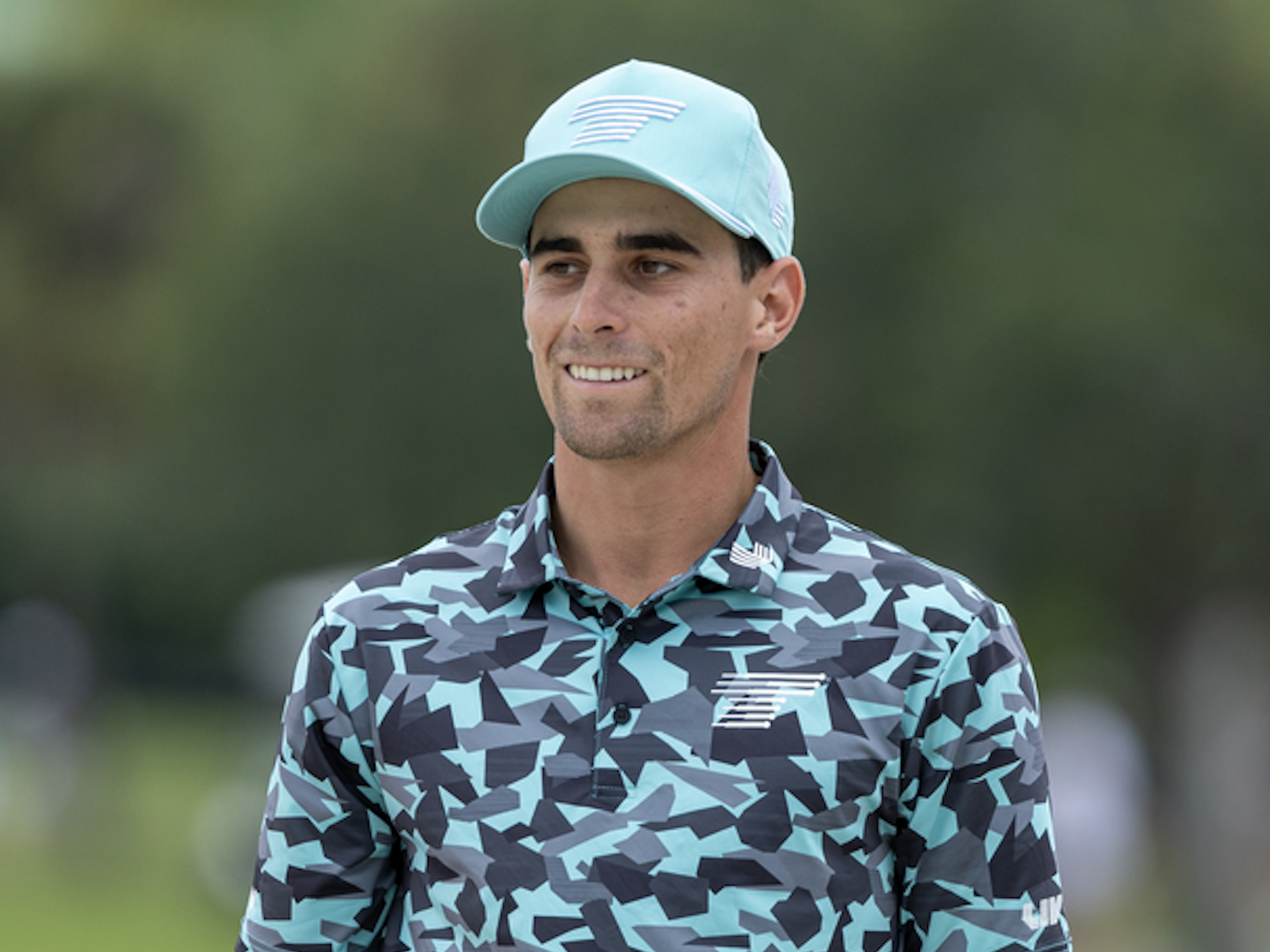
It’s been over nine months since we saw Brian Harman parlay a dominant performance at Royal Liverpool into a claret jug. After another major offseason filled with a feud between the PGA Tour and LIV Golf, talks of a merger, and a multitude of questions regarding the future of the game, the golf world is desperate for all of the best players in the world to come together again for a major championship.
We return to Augusta National with excitement at a fever pitch. Scottie Scheffler has separated himself as the best player in the world heading into the Masters. At the moment, the 27-year-old seems to be an unstoppable force. However, questions about Scheffler’s up-and-down putter once again resurfaced as he missed multiple short putts at the Texas Children’s Houston Open including a 5’11” putt to force a playoff with Stephan Jaeger.
Additionally, a handful of the PGA Tour’s top players such as Justin Thomas, Rory McIlroy, Will Zalatoris, Patrick Cantlay, Tommy Fleetwood and Jordan Spieth make their way to Augusta National with their current form in question.
Plenty of LIV golfers may be up to the task of conquering Augusta, but with so much time in between the last two majors, it’s not always easy to decipher how their games will stack up against Scheffler and co.
Last year, some important changes were made at Augusta National. The par-5 13th (Azalea) was lengthened by 35 yards and now measures 545 yards. Last year, Azalea played as the toughest of the four par 5s, and players averaged 4.74 for the week, which was down from 4.85 in 2022. However, eagles, birdies and bogeys were all up, so the lengthening achieved less pars, which equals more excitement.
Without further ado, let’s get into the course breakdown and analyze some important statistics for Augusta National.
Augusta National is now a 7,510-yard par-72 with lightning-fast Bentgrass greens. The course’s primary defenses are the contoured greens, swirling crosswinds, the topography of the course, which creates uneven lies and the small landing areas that golfers will need to hit to avoid tight run-off areas around the greens.
Past Winners at the Masters
- 2023: Jon Rahm (-12)
- 2022: Scottie Scheffler (-10)
- 2021: Hideki Matsuyama (-10)
- 2020: Dustin Johnson (-20)
- 2019: Tiger Woods (-13)
- 2018: Patrick Reed (-15)
- 2017: Sergio Garcia (-9)
- 2016: Danny Willett (-5)
- 2015: Jordan Spieth (-18)
- 2014: Bubba Watson (-8)
- 2013: Adam Scott (-9)
- 2012: Bubba Watson (-10)
- 2011: Charl Schwartzel (-14)
- 2010: Phil Mickelson (-16)
In this article and going forward, I’ll be using the Rabbit Hole by Betsperts Golf data engine to develop my custom model. If you want to build your own model or check out all of the detailed stats, you can sign up using promo code: MATTVIN for 25% off any subscription package (yearly is best value).
Key Stats For Augusta National
Let’s take a look at the six most important metrics at Augusta National and determine which golfers boast top marks in each category over their last 24 rounds. This should give us a good starting point for building out a betting card.
Strokes Gained: Approach
Approach is historically the most important statistic at Augusta National. The sloping, speedy greens and run-off areas create small landing spots that can be difficult to hit.
Last year, Jon Rahm ranked 6th in the field in Strokes Gained: Approach. Overall, five of the past seven winners at Augusta have ranked in the top 6 in the category. Distance helps, but Augusta National is a second-shot golf course.
Total Strokes Gained: Approach in past 24 rounds:
- Scottie Scheffler (+1.30)
- Corey Conners (+0.99)
- Shane Lowry (+0.88)
- Tony Finau (+0.85)
- Austin Eckroat (+0.85)
Course History
More so than any other course on TOUR, familiarity with Augusta National is crucial. Only one player has ever won the Masters on their first try — Fuzzy Zoeller in 1979. Meanwhile, there are 17 golfers in history who have multiple green jackets.
In most cases, the Masters champion has shown some good form at Augusta in the past. Prior to Scottie Scheffler’s 2022 victory, he finished T19 and T18 in his first two trips to the course. Prior to 2023, Rahm had finished in the top-10 of four of his six starts at The Masters.
Total Strokes Gained: Total at Augusta National in past 36 rounds (per round, minimum eight rounds):
- Will Zalatoris (+2.91)
- Jon Rahm (+2.28)
- Jordan Spieth (+2.22)
- Scottie Scheffler (+2.22)
- Dustin Johnson (+2.01)
- Rory McIlroy (+2.00)
- Hideki Matsuyama (+1.90)
- Justin Rose (+1.85)
- Rickie Fowler (+1.72)
- Russell Henley (+1.60)
Par 4 Scoring Average
Since plenty of players can reach the par 5s at Augusta in two, par-4 scoring becomes more important. The golfer who separates themselves on the par 4s will be able to gain ground on the field.
Par 4 Scoring Average in past 24 rounds:
- Scottie Scheffler (+3.88)
- Chris Kirk (+3.92)
- Jordan Spieth (+3.93)
- Peter Malnati (+3.93)
- Xander Schauffele (+3.93)
Strokes Gained: Around the Green
Golfers with a solid short game tend to fare well at Augusta National. The run-off areas are treacherous, and players will often be scrambling to get up and down.
The majority of players who have won at Augusta National have a great short game and have shown consistent ability to get up and down from tough spots.
Total Strokes Gained: Around the Green in past 24 rounds:
- Hideki Matsuyama (+0.71)
- Scottie Scheffler (+0.66)
- Patrick Reed (+0.61)
- Xander Schauffele (+0.53)
- Lucas Glover (+0.51)
Strokes Gained: Off the Tee
Augusta National is most definitely a second shot golf course. Golfers can get away with a missed fairway here and there, however, it’s important that the misses with driver aren’t too wide of the target or there is serious trouble to be had.
Total Strokes Gained: Off the Tee in past 24 rounds:
- Bryson DeChambeau (+1.04)
- Rory McIlroy (+0.85)
- Scottie Scheffler (+0.84)
- Xander Schauffele (+0.71)
- Ludvig Aberg (+0.68)
Strokes Gained Putting: Fast Bentgrass
The USGA calculates that, on average, the greens at Augusta National are the fastest greens in the country. Three-putting is fairly common at Augusta and golfers must be able to combat the speed of the greens with effective lag putting.
Total Strokes Gained: Putting on Fast Bentgrass in past 24 rounds:
- Justin Rose (+1.43)
- Sahith Theegala (+0.97)
- Min Woo Lee (+0.88)
- Cameron Smith (+0.70)
- Patrick Reed (+0.70)
Statistical Model
Below, I’ve reported overall model rankings using a combination of the six key statistical categories previously discussed.
These rankings are comprised of SG: App (25%); Course History (16%); Par 4 Scoring Average (10%); SG: Putting on Fast Bentgrass (16%); SG: OTT (16%). and SG: ARG (16%).
Last year, Jon Rahm ranked first in this model
- Scottie Scheffler
- Xander Schauffele
- Hideki Matsuyama
- Tony Finau
- Justin Thomas
- Shane Lowry
- Will Zalatoris
- Corey Conners
- Si Woo Kim
- Rory McIlroy
- Stephan Jaeger
- Jordan Spieth
- Chris Kirk
- Keegan Bradley
- Wyndham Clark
- Sahith Theegala
- Russell Henley
- Collin Morikawa
- Matt Fitzpatrick
- Patrick Reed
My 2023 Pick:
Jon Rahm (+950) (FanDuel)
A few months ago, I never thought that I’d be able to say that Rahm would be going slightly under the radar heading into the 2023 Masters. It’s not that Rahm has done anything wrong, but both Scheffler and McIlroy have undoubtedly surpassed him as the scorching hot, super-elite, top of the market betting favorite category.
Since his win at Riviera, the Spaniard has finished 39th at Bay Hill, withdrew at The Players Championship, and failed to get out of the group stage at the WGC Dell Match Play. On the other hand, Scheffler won The PLAYERS Championship and McIlroy finished third at the WGC Dell Match Play.
Rahm has made six starts at The Masters and has come in the top-10 in four of them. The 28-year-old has incredible power off the tee, a requirement at Augusta which always plays longer than the scorecard indicates. He’s also incredible around the greens and ranks third in the field in Strokes Gained: Short Game, which is a combination of around the green play and putting, in his past 24 rounds.
As we’ve seen over the years at The Masters, having the ability to chip and putt your way out of difficult situations is a fundamental aspect of getting it done at Augusta National.
While Scheffler has made a strong case to be viewed as the world’s best player, I still believe that title belongs to Rahm. This will be the year Rahmbo joins the ranks of Seve Ballesteros, José María Olazábal, and Sergio Garcia as natives of Spain to don a green jacket.
2024 The Masters Picks
Brooks Koepka +2500 (DraftKings)
In order to win the 2024 Masters, a player will have to go toe-to-toe with Scottie Scheffler, who’s hitting the ball as anyone in golf over the last two seasons. When building a betting card this week, it’s important for me to choose players that I believe can stare Scheffler down on the weekend at Augusta National. Brooks Koepka fits that bill.
Koepka’s lackluster performance at LIV Miami is concerning, but he’s the type of player who can turn it on quickly during the week of a major championship. Although I’d have preferred, he played well last week, I’ll take the odds discount we got as a result of his most recent results.
Prior to LIV Miami, Koepka appeared to be in solid form. He finished in the top twelve in four of five starts on LIV this season. When it comes to the five-time major champion, it’s well known that he has another gear for major championships. Everything he’s done both in the off-season and during the LIV season is to gear up for the year’s first major at Augusta National.
In his past five starts at Augusta National, the 33-year-old has three top-7 finishes, including two runners-up. The two years when he played poorly (2019 and 2020) were when he was nowhere near 100% healthy. All signs point to Brooks being in a great place physically as we enter major season.
Last year, Koepka was the 36 and 54-hole leader prior to letting the green jacket slip away to Jon Rahm. He used the result as a springboard to win his 5th major at Oak Hill at the PGA Championship.
Brooks enters the week looking to get one step closer to achieving the career grand slam and golf fans would be foolish to rule him out.
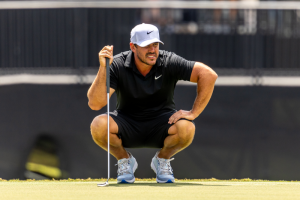
Joaquin Niemann +2800 (BetRivers)
Full disclosure, I bet Niemann the second he was invited to The Masters back in February at +8000. Although the odds have shortened dramatically since then, I can’t pretend that the Chilean isn’t one of the players who has a real chance to win the 2024 Masters.
While I was speaking with Niemann back in March, he told me how much he loves Augusta National.
“Yeah, it’s a place that I love. I’ve been playing good golf. Especially last year, I wasn’t playing my best golf, and I had a good week there and made triple on 11 that kind of killed me a little bit.
I feel like I’m getting more ready and more prepared every time. My game is getting better too. I know that I’m playing good enough to be in that situation that I can have a chance to win the Masters and it’s all about how I react to that situation.
So yeah, I’m going to prepare myself to be ready for that situation if it happens and I can fight for the title on the Sunday which would be awesome.”
As Niemann alluded to, the Chilean was able to have his best career finishes at The Masters (T16) despite not being in the best form. This year, Niemann comes into the week playing better golf than anyone in the world with the exception of Scottie Scheffler. The 25-year-old has won three times since December and has shown the world why he was regarded as one of the games future stars since he was a teenager.
Historically speaking, Joaco’s win at Riviera a few years back seems to be an indicator of potential success at Augusta National. Fourteen players have won at both historic courses including Hideki Matsuyama, Jon Rahm, Phil Mickelson, Dustin Johnson, Nick Faldo, Tom Watson and Ben Hogan.
Niemann has all the shots to be successful at Augusta National. His low stingers will come in handy on plenty of holes down the stretch and he can work it both ways, playing the high draw or the low fade. He also putts best on Bentgrass greens and likes them fast. Whether PGA Tour or LIV, talent will always reign supreme, and I’ll always bet on that talent.
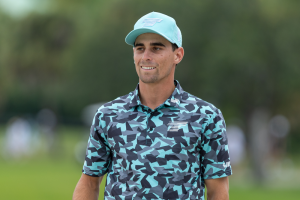
Cameron Smith (+4000) (FanDuel)
Cameron Smith is another player who we should get an odds discount on based off of the results at LIV Miami. Smith was forced to withdraw prior to the second round due to food poisoning. In my opinion, the number has drifted to a place where I’d consider it a “bet the number” play on the talent.
Smith is a contender for the green jacket anytime he tees it up at Augusta National. The Australian absolutely loves the golf course and has four top-10 finishes in his last six trips to the golf course. In both 2020 and 2022, Smith had a real chance of winning The Masters and came up just short, finishing T2 and T3 in those two tries. In his past 36 rounds, he ranks 4th in Strokes Gained: Total per round at Augusta.
In order to be successful at Augusta National, players must be creative around the greens and be shot makers who have plenty of ways to get around the golf course. Cam has all the shots required to be successful at the course at his touch around the greens will continue to serve him well in his hopes for a green jacket.
Smith is arguably the best putter in the world and has the capability to win a golf tournament on and around the greens. He’s already taken down Rory McIlroy at the home of golf on his way to a claret jug and is one of the few players who can stare down any of the world’s top golfers on the back nine at Augusta National.
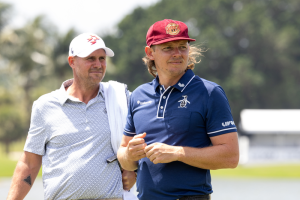
Justin Thomas +4000 (FanDuel)
With how he’s been playing since his 2022 PGA Championship win, you may be shocked to see the name “Justin Thomas” in this preview. However, JT has drifted to a place on the odds board where I believe it’s worth taking a shot on the talent of a two-time major champion in his prime.
It’s not all bad for Thomas this season. He finished T6 at the signature Pebble Beach event, T12 at the Waste Management Phoenix Open and T12 at the signature Arnold Palmer Invitational. In his last 24 rounds, JT ranks 8th in the field in Strokes Gained: Approach, 14th in Strokes Gained: Around the Green and 29th in Strokes Gained: Putting on fast Bentgrass greens.
Despite missing the cut last season, Thomas has played pretty well at Augusta National. He ranks 13th in Strokes Gained: Total in his past 36 rounds at the course. He finished T4 in 2020, T21 in 2021 and T8 in 2022.
I believe the 2024 edition of The Masters is completely wide open. The past few years has been frustrating for Thomas fans, but I believe his peak form may be a bit closer than people realize.
Sergio Garcia +12000 (FanDuel)
Earlier this season, Garcia dueled with Joaquin Niemann before finally losing on the fourth playoff hole late into the night. Despite the loss, the 44-year-old seemed to gain confidence in his game. The results that followed weren’t spectacular, but in terms of his ball striking he’s shown some flashes of vintage Sergio.
At LIV Miami last week, Garcia played well on a massive golf course, losing in a playoff to Dean Burmester. He continued pumped the ball into the fairway and hit massive iron shot after massive iron shot. He also used a refurbished Scotty Cameron that he used in the 1999 PGA Championship at Medinah. The putter served him incredibly well until he missed a short putt on the 18th hole to win the event. Overall, he gained 7.1 strokes putting at Doral.
Sergio Garcia is once again headed to Augusta National with a chip on his shoulder. Of course, having a chip on the shoulder is nothing new for the fiery Spaniard, but this year, the 2017 Masters Champion will arrive at Augusta with his game clicking on all cylinders.
Sergio winning a second green jacket is seemingly an almost impossible feat, but magical things tend to happen on the hallowed grounds of Augusta National.
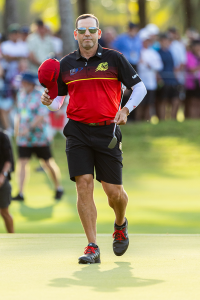
Adam Scott +11000 (FanDuel)
Betting Adam Scott over the past handful of years has been a Masters staple for me, and like many traditions, has been a hard one for me to let go of.
Last week, Scott finished T14 at the Valero Texas Open in a windy and difficult week. I believe the wind will be a major factor this week at Augusta National, and the more difficult the tournament plays, the more I favor Scott. Scott also ranks 5th in his past 24 rounds on Strokes Gained: Putting on Fast Bentgrass and has the short game these days that could help him contend in a major.
Since his win in 2013, Scott’s history at The Masters has been spotty. He has some poor finishes alongside a T9 in 2017 and a T18 in 2019. He’s been playing some solid golf this season, finishing T8 at the Waste Management Phoenix Open and T19 at the Genesis Invitational.
(All photos in piece belong to LIV Golf)
- LIKE35
- LEGIT22
- WOW8
- LOL2
- IDHT0
- FLOP6
- OB2
- SHANK22
Opinion & Analysis
The 22 players who can win the Masters
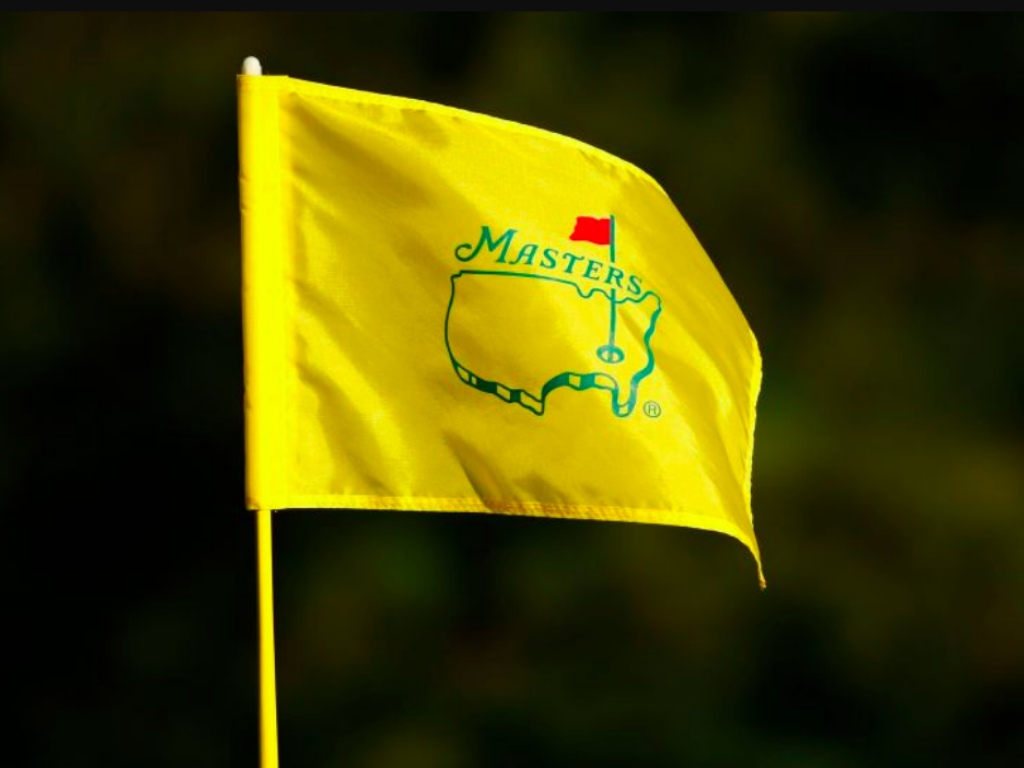
Since 2013, I have created a filtering process to help determine the players who are most likely to win the green jacket based on criteria that have strongly predictive outcomes to success at Augusta. The list of players that can win at Augusta is usually filtered down to 20-24 players and in that time I have correctly shortlisted every Masters champion.
This includes last year’s winner, Jon Rahm. Even though Rahm essentially walked away with the green jack and did not make it very close, there were some close calls on top of the leaderboard as I had filtered out Phil Mickelson (t-2nd) and Patrick Reed (t-4th) as the LIV Tour is still behind on providing advanced analytics for their tour. Russell Henley was also filtered out and finished t-4th, five strokes from Rahm’s winning score of 276.
If you’re watching at home, the “critical holes” that will likely determine the top finishers will be holes No. 7, 8, 11 and 13. The 11th hole is projected to be the most critical of holes as over the past five Masters the top players have gained nearly a 1.5 strokes for the tournament on that hole alone.
Just like last year’s column I will get the LIV Tour players I’ve filtered out of the way. Since LIV Tour does not provide ShotLink or Trackman data, it’s more of a guessing game as to how certain LIV Tour golfers are playing. I did utilize recent performance as well as performance at Mayakoba and Doral as they were two former PGA Tour courses that have some semblance of crossover to playing Augusta.
Phil Mickelson
Thorbjorn Olesen
Charl Schwartzel
Cameron Smith
Bubba Watson
Admittedly Cameron Smith and Phil Mickelson are hard to leave out, but both have not played well as of late.
Next, I filtered out the amateurs and all first-time professional attendees. The Masters has only been won three times by a first-time attendee: Fuzzy Zoeller was the last to win in 1979. Prior to Zoeller though, it was Horton Smith in the inaugural event in 1934 followed by Gene Sarazen in 1935
Ludvig Aberg
Akshay Bhatia
Wyndham Clark
Eric Cole
Santiago de la Fuente (a)
Nick Dunlap
Austin Eckroat
Stewart Hagestad (a)
Ryo Hisatsune
Lee Hodges
Nicolai Hojgaard
Stephan Jaeger
Jake Knapp
Christo Lamprecht (a)
Peter Malnati
Denny McCarthy
Grayson Murray
Matthieu Pavon
Adam Schenk
Neal Shipley (a)
Jasper Stubbs (a)
Out of the first time invitees the data likes Ludvig Aberg and Eric Cole to play the best at Augusta National.
I also filter out old Masters champions that I do not believe can get into contention anymore.
Fred Couples
Jose Maria Olazabal
Vijay Singh
Mike Weir
Tiger Woods
Recency has a strong predictive value for player performance and missing the cut in the event in the prior week greatly reduces the likelihood of winning the following week compared to players that miss the cut, take a week off, and then play the following week. Therefore I filter out all players that missed the cut at the Valero Texas Open last week.
Byeong Hun An
Harris English
Rickie Fowler
Ryan Fox
Zach Johnson
Tom Kim
Erik van Rooyen
Camilo Villegas
I will also filter out the players that have never made the cut at the Masters:
Kurt Kitayama
Adrian Meronk
A Tradition Unlike Any Other…
Augusta National has traditionally favored longer hitters and even moreso in the past 20 years of the event. Of course there has been exceptions as in 2007 the short hitting Zach Johnson ended up winning the event.
Critics of my filtering system point out Johnson’s victory as a case for short hitters being able to win at Augusta, but they neglect the fact that Johnson’s victory came in historically low temperatures in the 40’s with wind gusts reaching 35 mph. That made the par-5’s almost unreachable in two shots and the course stressed wedge play and short game around the green where Zach had a sizable advantage.
It is projected to rain early on Thursday and then the weather is supposed to be sunny and warm for the rest of the week. It depends on how quickly the course dries up, but if it does dry out fairly quickly that will give the longer hitters the advantage as they will be able to reach certain par-5’s in two shots that the shorter hitters cannot reach if they don’t hit a quality tee shot and there may be par-5’s that some of the long hitters can reach in two shots with a short iron. Therefore I will filter out the following players due to a lack of distance off the tee:
Corey Conners
Lucas Glover
Emiliano Grillo
Brian Harman
Si Woo Kim
Chris Kirk
Shane Lowry
Colin Morikawa
JT Poston
Justin Rose
Sepp Straka
Out of these players the data likes Lowry and Morikawa the most. Both have good history at Augusta and they both just narrowly missed the distance benchmark set in the filter and both are excellent long iron players.
Last year I created a new formula to better determine ball height as Augusta has historically not taken too kindly to a low ball flight. Out of the 5 players filtered out for low ball flight using the new formula the best finish was only t-29th by Si Woo Kim. This year I’ve filtered out the following players.
Matthew Fitzpatrick
Sungjae Im
Luke List
Joaquin Niemann
Justin Thomas
Every year I filter out the poor performers on approach shots from 175-225 yards as Augusta National puts a lot of stress on those shots. Last year I filtered out nine players and three of them missed the cut with only Jordan Spieth finishing in the top-15 (t-4th) as the rest of the players were never a threat.
Here are the golfers I’m filtering out due to poor play from 175-225 yards:
Patrick Cantlay
Cameron Davis
Jason Day
Tommy Fleetwood
Russell Henley
Max Homa
Rory McIlroy
Jordan Spieth
Nick Taylor
Rory had a nice outing at the Valero Texas Open and hit his irons better there, but appears to be struggling with a leftward miss. Other than that, Rory still has the game to win his first green jacket. Henley is usually one of the better iron players on Tour, but he has struggled this season from 175-225 yards and is a short hitter anyway.
I will also filter out Danny Willett as he is coming off injury and making his comeback at the Masters.
That leaves the 22 players that can win the Masters:
Keegan Bradley (150/1)
Sam Burns (60/1)
Bryson DeChambeau (25/1)
Tony Finau (50/1)
Sergio Garcia (100/1)
Adam Hadwin (175/1)
Tyrrell Hatton (80/1)
Viktor Hovland (35/1)
Dustin Johnson (40/1)
Brooks Koepka (16/1)
Min Woo Lee (70/1)
Hideki Matsuyama (20/1)
Taylor Moore (300/1)
Jon Rahm (12/1)
Patrick Reed (80/1)
Xander Schauffele (18/1)
Scottie Scheffler (4/1)
Adam Scott (100/1)
Sahith Theegala (50/1)
Gary Woodland (250/1)
Cameron Young (50/1)
Will Zalatoris (35/1)
Here’s my personal top-10 picks:
Keegan Bradley (150/1)
Sam Burns (60/1)
Bryson DeChambeau (35/1)
Tony Finau (50/1)
Viktor Hovland (35/1)
Dustin Johnson (40/1)
Hideki Matsuyama (20/1)
Jon Rahm (12/1)
Xander Schauffele (18/1)
Scottie Scheffler (4/1)
- LIKE185
- LEGIT75
- WOW24
- LOL25
- IDHT5
- FLOP12
- OB7
- SHANK63
-

 19th Hole3 days ago
19th Hole3 days agoDave Portnoy places monstrous outright bet for the 2024 Masters
-

 19th Hole3 weeks ago
19th Hole3 weeks agoJohn Daly stuns fans into silence with brutal opening tee shot on PGA Tour Champions
-

 19th Hole2 weeks ago
19th Hole2 weeks agoThings got heated at the Houston Open between Tony Finau and Alejandro Tosti. Here’s why
-

 19th Hole4 days ago
19th Hole4 days agoTiger Woods arrives at 2024 Masters equipped with a putter that may surprise you
-

 19th Hole1 week ago
19th Hole1 week agoReport: Tiger Woods has ‘eliminated sex’ in preparation for the 2024 Masters
-

 19th Hole3 weeks ago
19th Hole3 weeks agoCharlie Woods finds it tough going on American Junior Golf Association debut
-

 19th Hole2 weeks ago
19th Hole2 weeks agoAddiction, spinal fusion, and scam artists – Everything Anthony Kim revealed in candid interview with David Feherty
-

 19th Hole1 week ago
19th Hole1 week agoAnthony Kim says doctors told him that he ‘may not have much time left’ ahead of LIV return



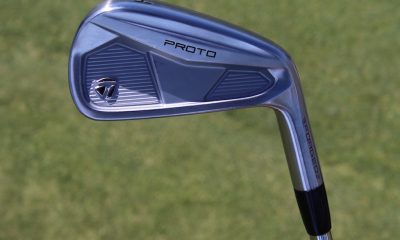

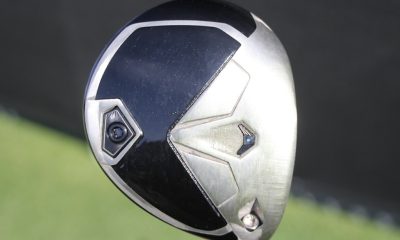

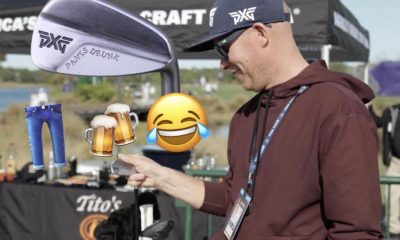

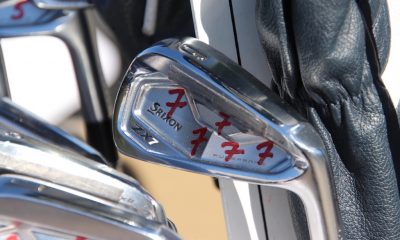

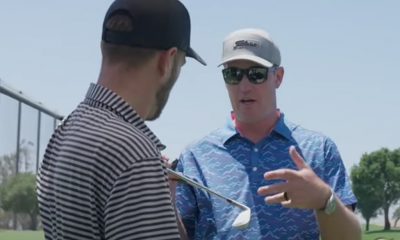

















Bruce
May 19, 2017 at 9:21 am
Written from an OEM perspective; that is, throw away a good idea to preserve the business profits. Quit bringing up red herring non-issues for marketing reasons. If we all played single length and someone introduced variable length, what an uproar that would cause. Golf is a marketing driven business: very very little science (I am a PhD Mechanical Engineer who understands golf science). Single length irons make good sense. Multiple length irons and swing weight matching HAVE NO BASIS IN SCIENCE. These are all marketing.
Mat
May 20, 2017 at 7:29 pm
Actually, multi-length irons have plenty of basis in science. They use length of shaft as one of two main properties that provide distance gaps between irons. By doing this, they can achieve a more consistent descent angle, apex, and distance range within a set.
These are the issues that SLI are working hard to overcome. There have been advancements, but that doesn’t mean they’re perfect. But for a ME PhD to go on about how MLI have no basis is ignorant.
Dave R
Apr 26, 2017 at 10:07 pm
Ken I think you need a hug.
Eddie
Apr 26, 2017 at 6:32 pm
Talent will always trump equipment. No piece of equipment will ever make or break someone’s golf career.
The dude
Apr 26, 2017 at 4:55 pm
What I don’t understand….why it takes someone forever to share their thoughts on a post. If it’s longer than 5 lines…just read the last sentence….
Scott
Apr 26, 2017 at 4:06 pm
Just because you have a different grip with different clubs does not mean everyone else does. And just how many 6′ 4″ juniors do you come across? Wow.
Philip
Apr 26, 2017 at 2:29 pm
They are if you are an OEM that wants to start a new batch of players that will not have an enormous supply of cheaper used clubs to pick from once they grow up and can spend their own money.
cody
Apr 26, 2017 at 1:18 pm
I have a 5 year old girl that i would like to get into golf. I will be honest i dont see a donw side to single length irons to start with. Are you all really saying that a kid cannot switch to more traditional clubs at some point?? c’mon man!!!
Mat
Apr 26, 2017 at 4:09 am
Navel gazing. If a kid is starting out, they get a lower learning curve. Fantastic.
What makes anyone think that the equipment they had as a 14 year old will affect them as an adult? Seriously, if you’re talking about things like apex height and swing weight to a 14 year old, not only is it a relevant conversation, let them choose themselves!
This product is designed for Daddy Upper-middle-class to give to his kid as a starter set that does not suck. This is not, at all, for serious kids. The serious kid MIGHT strip the crap shaft and play something else if they want SLI, but you’re talking a few very good kids with parental bankroll.
Arguing against quality options for kids is not growing the game. It’s the opposite.
AussieAussieAussie
Apr 26, 2017 at 12:35 am
I still can not understand why so many people hate the idea of single length irons? If a kid starts out playing golf with a single length set in years to come- when they have made them for the 3-5yr old age groups, then he or she will know no different than to use single length, to them varying length could be a foreign and ridiculous concept. Ultimately we want to as golfers grow the game- however that be. Relaxed dress codes, cheaper big name brand clubs more realist available, so why not just embrace the change, I’m sure hybrids and lob wedges were seen as a fad at the time of establishment? Yet here we are with most of us having one or both in our bag?! If one length works great, if it doesn’t that’s also fine! I wouldn’t expect you all to go swing like Jim Fuyrk just because it works for him. It’s not likely to work for you but no one begrudges him his success as a result of it?!
Ken
Apr 26, 2017 at 12:09 am
I bought a set of Tommy Armour EQLs many years ago and got rid of them for that exact reason. I couldn’t use my 7 iron left hand grip for the other clubs and particularly for the low loft clubs. Junior golfers who try to use these clubs will limit their progress and likely never make it into the pro tours.
Scott
Apr 26, 2017 at 4:04 pm
That is quite a leap to think that someone starting the game should not start with an easier system, then move into a different set that may work better for them down the road. I started with blades and persimmon woods – certainly a world of difference over today’s equipment.
Andrew you could not be any more wrong.
Scott
Apr 26, 2017 at 4:04 pm
Ken,
As if you could even know that.
Prime21
Apr 25, 2017 at 9:07 pm
It’s like everything else in golf, it will work for some, not for others. Hopefully Cobra is willing to supply a Demo Set so that Juniors could test them out prior to purchasing. Wishful thinking, but a thought!
Ken
Apr 26, 2017 at 12:12 am
Good junior golfers will never adapt to the single length/single shaft lie clubs because it will be too frustrating for younger minds to go through the trial and error phase of conversion.
Scott
Apr 26, 2017 at 4:10 pm
Ken,
Juniors are probably the BEST at going through a learning phase because they can look at things with an open mind and have not been influenced by people such as yourself.
RI_Redneck
Apr 25, 2017 at 8:48 pm
IMHO:
Shafts should have been steel.
Heads should have adjustable weights to adjust for longer lengths for varying heights and as the kid grows.
Price should be lower (steel shafts hep here).
It would have AT LEAST offered length options based on the kids height. Overlooking this greatly hamstrings Cobra’s ability to market these to the young masses. 13-15 yr olds height can vary A LOT. Good concept, but poor marketing.
BT
Steve
Apr 25, 2017 at 2:11 pm
Why is nobody complaining about the insane cost? This is at least at the same cost as a set of regular irons $90 per. How can that ever be good for junior golf?
mvhoffman
Apr 25, 2017 at 2:00 pm
I just have a feeling that these will continue to be developed. Players will soon start to play these from the start of their golf “career”. The USGA will wait, and wait, and wait…. and wait… just like they did with the belly putter, and then find a loophole to take these away and destroy more careers… I’m going to start a thread on this.
Ken
Apr 26, 2017 at 12:16 am
Parents who buy such clubs for their aspiring amateur golfer and hopefully a golf scholarship are only trying to cover up the swing faults of their child. That’s the only reason an adult will buy them too. An expensive band-aid remedy for a poor swing with regular clubs.
Brandon
Apr 26, 2017 at 4:58 pm
Ok, you can say whatever you want, but don’t you even dare thinking about using a putter that isn’t a blade. On that note, trade in your 460 cc driver for a good old fashioned steel shaft 975D driver, as current day drivers are also an “expensive band-aid for a poor swing”.
Tom 1
Apr 25, 2017 at 11:24 am
Yes